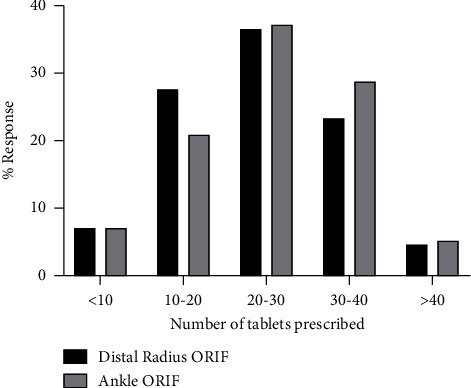Attitudes and Practices Surrounding Opioid Prescriptions following Open Reduction Internal Fixation of Distal Radius and Ankle Fractures: A Survey of the Canadian Orthopaedic Association Membership.
IF 1.6
Q3 ORTHOPEDICS
引用次数: 0
Abstract
Background The past two decades have seen a significant increase in consequences associated with nonmedical misuse of prescription opioids, such as addiction and unintentional overdose deaths. This study aimed to use an electronic survey to assess attitudes and opioid-prescribing practices of Canadian orthopaedic surgeons and trainees following open reduction internal fixation (ORIF) of distal radius and ankle fractures. This study was the first to assess these factors following ORIF of distal radius and ankle fractures using a survey design. Methods A 40-item survey was developed focusing on four themes: respondent demographics, opioid-prescribing practice, patients with substance use disorders, and drug diversion. The survey was distributed among members of the Canadian Orthopaedic Association. Descriptive statistics were used to summarize respondent demographics and outcomes of interest. A Chi-square test was used to determine if proportion of opioid prescriptions between attending surgeons and surgeons in training was equal. Results 191 surveys were completed. Most respondents prescribed 10–40 tabs of immediate-release opioids, though this number varied considerably. While most respondents believed patients consumed only 40–80% of the prescribed opioids (73.6%), only 28.7% of respondents counselled patients on safe storage/disposal of leftover opioids. 30.5% of respondents felt confident in their knowledge of opioid use and mechanisms of addiction. Most respondents desired further education on topics such as procedure-based opioid-prescribing protocols (74.2%), alternative pain management strategies (69.7%), and mechanisms of opioid addiction (49.0%). Conclusions The principle finding of this study is the lack of a standardized approach to postoperative prescribing in distal radius and ankle fractures, illustrated by the wide range in number of opioids prescribed by Canadian orthopaedic surgeons. Our data suggest a trend towards overprescription among respondents following distal radius and ankle ORIF. Future studies should aim to rationalize interventions targeted at reducing postoperative opioid prescribing for common orthopaedic trauma procedures.

桡骨远端和踝关节骨折切开复位内固定术后阿片类药物处方的态度和实践:加拿大骨科协会会员调查。
背景:在过去的二十年里,非药物滥用处方阿片类药物的后果显著增加,如成瘾和非故意过量死亡。本研究旨在使用电子调查来评估加拿大整形外科医生和受训人员在桡骨远端和踝关节骨折切开复位内固定术(ORIF)后的态度和阿片类药物处方实践。本研究首次采用调查设计评估桡骨远端和踝关节骨折ORIF后的这些因素。方法:制定了一项40项调查,重点关注四个主题:受访者人口统计、阿片类药物处方实践、药物使用障碍患者和药物转移。该调查在加拿大骨科协会的成员中分发。描述性统计用于总结受访者的人口统计数据和感兴趣的结果。卡方检验用于确定主治外科医生和接受培训的外科医生之间阿片类药物处方的比例是否相等。结果:完成了191项调查。大多数受访者开了10-40片立即释放的阿片类药物,尽管这个数字差异很大。虽然大多数受访者认为患者只摄入了处方阿片类药物的40-80%(73.6%),但只有28.7%的受访者建议患者安全储存/处置剩余阿片类。30.5%的受访者对自己对阿片类药物的使用和成瘾机制的了解充满信心。大多数受访者希望进一步了解基于程序的阿片类药物处方方案(74.2%)、替代疼痛管理策略(69.7%)和阿片类成瘾机制(49.0%)等主题。结论:本研究的主要发现是缺乏桡骨远端和踝关节骨折术后处方的标准化方法,加拿大整形外科医生开出的阿片类药物种类繁多。我们的数据表明,桡骨远端和踝关节ORIF后,受试者有过度用药的趋势。未来的研究应旨在合理化干预措施,以减少常见骨科创伤手术的术后阿片类药物处方。
本文章由计算机程序翻译,如有差异,请以英文原文为准。
求助全文
约1分钟内获得全文
求助全文
来源期刊

Advances in Orthopedics
ORTHOPEDICS-
CiteScore
2.40
自引率
0.00%
发文量
36
审稿时长
21 weeks
期刊介绍:
Advances in Orthopedics is a peer-reviewed, Open Access journal that provides a forum for orthopaedics working on improving the quality of orthopedic health care. The journal publishes original research articles, review articles, and clinical studies related to arthroplasty, hand surgery, limb reconstruction, pediatric orthopaedics, sports medicine, trauma, spinal deformities, and orthopaedic oncology.
 求助内容:
求助内容: 应助结果提醒方式:
应助结果提醒方式:


